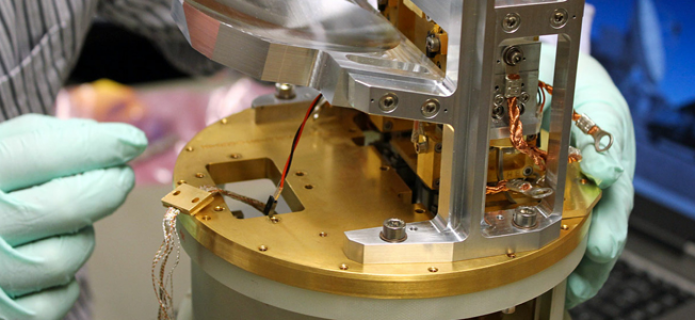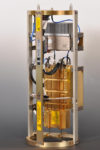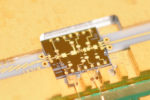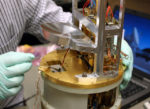ALMA Telescope Upgrade to Power New Science
Before its construction is even completed, the new ALMA (Atacama Large Millimeter/submillimeter Array) telescope is embarking on an upgrade that will help astronomers investigate the earliest galaxies and search for water in other planetary systems. The oversight board for ALMA has authorized in April 2012 the design and building of an additional set of receivers with state-of-the-art performance, which will enable the telescope to access a portion of the spectrum of light that it cannot currently study.
ALMA is the world’s largest astronomy project, and this powerful new facility located at 5,000 meters altitude in northern Chile is giving astronomers insight both into how the Universe and its galaxies have evolved since the Big Bang, and how stars and planetary systems formed in our own galaxy. Although only half of its final total of 66 antennas are currently in place at the high altitude Chajnantor plateau (see announcement), ALMA is already operating and making science observations with a partial array (see Press Release about ALMA Early Science and first ALMA observations results).
ALMA observes the Universe in radio waves: light which is invisible to our eyes. The weak glow coming from space is collected by the ALMA antennas and focused onto the receivers that transform the feeble radiation into an electrical signal. The new receivers will be able to detect electromagnetic radiation with wavelengths between about 1.4 and 1.8 millimeters, one of the ranges of the spectrum to which Earth's atmosphere is partially transparent, which allows the light to reach the ALMA antennas. These wavelengths correspond to radio frequencies between 163 and 211 Gigahertz.
The project will be undertaken jointly by two of ALMA's regional partners. The European Southern Observatory (ESO) will oversee development of the cryogenically cooled receivers, which will be fabricated by the Netherlands Research School for Astronomy (NOVA) in partnership with the Onsala Space Observatory’s Advanced Receiver Development group, based at Chalmers University of Technology in Gothenburg, Sweden. In North America, the National Radio Astronomy Observatory (NRAO) will build the high-precision oscillators that will tune the receivers, so that the output from all antennas can be precisely combined to make high-resolution images.
Over the next five years, each of ALMA's 66 dish antennas will be outfitted with one of the new "Band 5" receivers. These receivers will allow study of the radio waves coming from some of the earliest galaxies in the universe and will help us to understand when some of the first stars formed. They will also enhance astronomers' abilities to measure the presence of water -a molecule essential to life- in the dusty disks where planets are believed to form, and in the atmospheres of planets and comets in our own solar system. Water in space can be tricky to measure accurately, because of the confusing effects of observing through water vapor in Earth's atmosphere. The way in which ALMA's Band 5 receivers will measure water reduces some of these difficulties.
Six of these receivers have already been built and supplied to ALMA under the European Commission (EC) supported “Framework Programme FP6” (ALMA Enhancement). This program, led by the Advanced Receiver Development Group at Onsala Space Observatory, in collaboration with the Rutherford Appleton Laboratory, UK, and ESO, started in 2006. It focused on the design, development, prototyping and supply of these receivers.
Another 67 of the cold cartridge assemblies, that operate at -269 degrees Celsius, will be built by the partnership led by NOVA, which will bring the total to 73, enough for all 66 antennas plus spares. Similarly, a total of 73 Band 5 oscillator cartridge assemblies will be built at the NRAO Technology Center in Charlottesville, Virginia. They will be attached to the European receiver cartridges and the combined assemblies will be installed inside the ALMA antennas.
Links:
NOVA, the research school for astronomy in the Netherlands
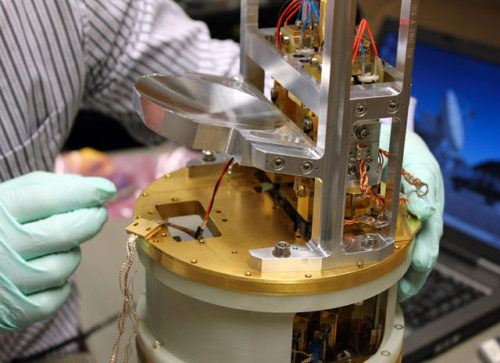
This picture shows one of the first six Band 5 receiver cartridges built for the Atacama Large Millimeter/submillimeter Array (ALMA). Extremely weak signals from space are collected by the ALMA antennas and focused onto the receivers, which transform the faint radiation into an electrical signal. The Band 5 receivers detect electromagnetic radiation with wavelengths between about 1.4 and 1.8 millimeters (211 and 163 gigahertz).
The receivers were originally designed, developed, and prototyped by Onsala Space Observatory’s Advanced Receiver Development group, based at Chalmers University of Technology in Gothenburg, Sweden, in collaboration with the Rutherford Appleton Laboratory, UK, and ESO, under the European Commission (EC) supported Framework Programme FP6 (ALMA Enhancement)
Credit: Onsala Space Observatory/Alexey Pavolotsky
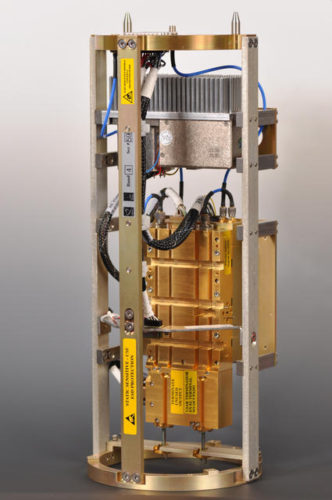
An ALMA Warm Cartridge Assembly (WCA) containing the precision oscillators and support electronics needed for precise tuning of receivers. As with all ALMA production receivers, this WCA was produced by the National Radio Astronomy Observatory's Technology Center in Charlottesville, Virginia.
Credit: NRAO/AUI/NSF
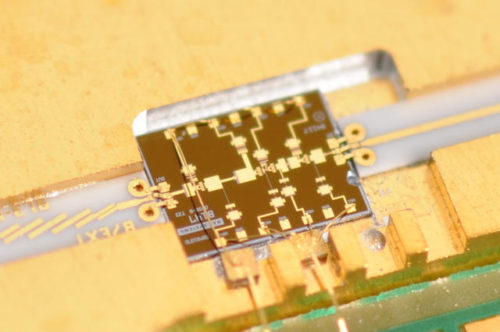
A close-up of a crucial component of an ALMA Warm Cartridge Assembly, a custom power amplifier chip designed by NRAO engineers and fabricated by BAE Systems of Nashua, New Hampshire, using a process that enables such amplifiers to work at frequencies above the normal 100 gigahertz limit of commercially available devices of this type.
Credit: NRAO/AUI/NSF
Contacts:
William Garnier
ALMA Education and Public Outreach Officer
Santiago, Chile
Tel: +56 2 467 6119
Email: [email protected]
Douglas Pierce-Price
ESO ALMA Public Information Officer
Garching, Germany
Tel: +49 89 3200 6759
Email: [email protected]
Hans Rykaczewski
ALMA Enhancement Programme Co-ordinator, ESO
Garching, Germany
Tel: +49 89 3200 6630
Email: [email protected]
John Stoke
Assistant Director, Education and Public Outreach
National Radio Astronomy Observatory
Charlottesville, VA, USA
Tel: +1-434-244-6896
Email: [email protected]
